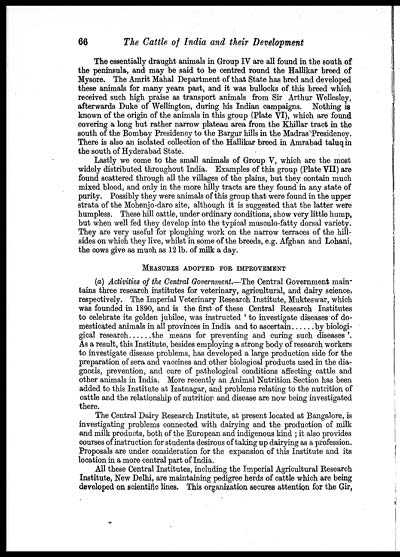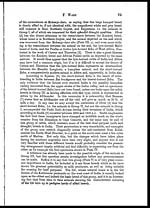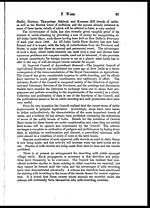Medicine - Veterinary > Veterinary colleges and laboratories > Indian journal of veterinary science and animal husbandry > Volume 12, 1942 > Original articles > Cattle of India and their development
(76) Page 66
Download files
Individual page:
Thumbnail gallery: Grid view | List view

66 The Cattle of India and their Development
The essentially draught animals in Group IV are all found in the south of
the peninsula, and may be said to be centred round the Hallikar breed of
Mysore. The Amrit Mahal Department of that State has bred and developed
these animals for many years past, and it was bullocks of this breed which
received such high praise as transport animals from Sir Arthur Wellesley,
afterwards Duke of Wellington, during his Indian campaigns. Nothing is
known of the origin of the animals in this group (Plate VI), which are found
covering a long but rather narrow plateau area from the Khillar tract in the
south of the Bombay Presidency to the Bargur hills in the Madras Presidency.
There is also an isolated collection of the Hallikar breed in Amrabad taluq in
the south of Hyderabad State.
Lastly we come to the small animals of Group V, which are the most
widely distributed throughout India. Examples of this group (Plate VII) are
found scattered through all the villages of the plains, but they contain much
mixed blood, and only in the more hilly tracts are they found in any state of
purity. Possibly they were animals of this group that were found in the upper
strata of the Mohenjo-daro site, although it is suggested that the latter were
humpless. These hill cattle, under ordinary conditions, show very little hump,
but when well fed they develop into the typical musculo-fatty dorsal variety.
They are very useful for ploughing work on the narrow terraces of the hill-
sides on which they live, whilst in some of the breeds, e.g. Afghan and Lohani,
the cows give as much as 12 lb. of milk a day.
MEASURES ADOPTED FOR IMPROVEMENT
(a) Activities of the Central Government.—The Central Government main-
tains three research institutes for veterinary, agricultural, and dairy science,
respectively. The Imperial Veterinary Research Institute, Mukteswar, which
was founded in 1890, and is the first of these Central Research Institutes
to celebrate its golden jubilee, was instructed ' to investigate diseases of do-
mesticated animals in all provinces in India and to ascertain......by biologi-
gical research......the means for preventing and curing such diseases '.
As a result, this Institute, besides employing a strong body of research workers
to investigate disease problems, has developed a large production side for the
preparation of sera and vaccines and other biological products used in the dia-
gnosis, prevention, and cure of pathological conditions affecting cattle and
other animals in India. More recently an Animal Nutrition Section has been
added to this Institute at Izatnagar, and problems relating to the nutrition of
cattle and the relationship of nutrition and disease are now being investigated
there.
The Central Dairy Research Institute, at present located at Bangalore, is
investigating problems connected with dairying and the production of milk
and milk products, both of the European and indigenous kind ; it also provides
courses of instruction for students desirous of taking up dairying as a profession.
Proposals are under consideration for the expansion of this Institute and its
location in a more central part of India.
All these Central Institutes, including the Imperial Agricultural Research
Institute, New Delhi, are maintaining pedigree herds of cattle which are being
developed on scientific lines. This organization secures attention for the Gir,
Set display mode to: Large image | Zoom image | Transcription
Images and transcriptions on this page, including medium image downloads, may be used under the Creative Commons Attribution 4.0 International Licence unless otherwise stated. ![]()
| Permanent URL | https://digital.nls.uk/75259313 |
|---|
| Description | Covers articles from 1942. |
|---|




